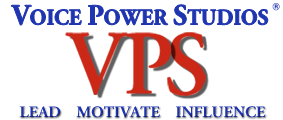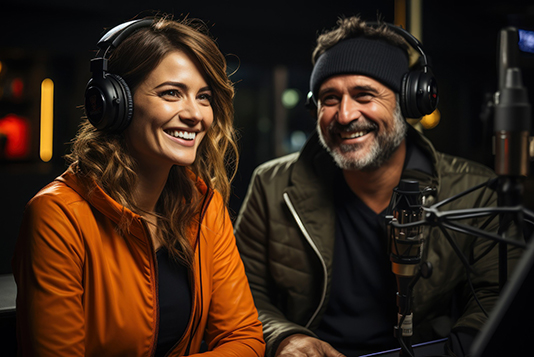My best piece of advice: practice. Practice by yourself. Practice with a friend. Make one or two or even three podcasts that you can listen to afterward.
That’s the best first thing you can do: a dress rehearsal. Listen to it. Take notes on what you’re hearing—in your voice, in your rhythm, the way you ask a question, the way you listen to whoever it is you’re interviewing, other sounds, the quality of the recording itself, your tone, your mood, your presence. These are all elements of a podcast that you’ll want to work through before you actually post your first podcast.
I myself have done about a dozen podcasts now—The Celebrate Happiness Roadshow Podcast with Sandra M —and even for me, a voice coach who’s been training other people for over 40 years on how to be a better speaker, a better listener, a better communicator, I have learned a great deal.
As a performer, as someone who’s been in soap operas, TV sitcoms, sings professionally and who’s produced my own cabaret shows, I speak from experience. And I can’t think of a play or a TV show or a film that did not rehearse before being presented to others. And podcasting is no different. Sure, there are people who can—or even seem to prefer to—fly by the seat of their pants. Who do great at extemporizing and just making it up as they go along. And if that’s you, great. But even if that is you, you should practice that spontaneity beforehand—just to make sure that it actually works, that that’s actually your podcasting persona. However for most people, myself included, I prefer to know what I’m doing ahead of time and where I want to go with a podcast. Not that whoever I’m interviewing won’t surprise me (and my listeners)—that’s great. That’s often what you want: the unexpected. And the best preparation for the unexpected is to be secure in yourself before somebody throws you a curveball and you’re unsure or unprepared for how to deal with it.
As you’re going through your practice sessions, remember: your voice is your calling card. This is what listeners will respond to as much if not more than your actual content. So pay attention to your speaking voice. Are you speaking too fast? (Very common. A good talking speed is about 150 words per minute.) Are you speaking too slowly? Too loudly? Too softly? Are you mumbling? Are there too many pauses? Are you relying too much on filler words and sounds and verbal tics: “like,” “Ummmm,” “Right?” “you know,” “ah,” “er,” “I mean,” “OK,” “So, actually,” “basically.”
And if the volume of your voice is not strong, even if you’re confident in what you’re saying, that not-so-strong volume can impart fear, discomfort, anxiety. These are all qualities that listeners pick up on—intuitively. Listeners rely on your voice as much as you do; your voice inspires and motivates them to keep listening.
Use these dry runs to think about how you sound—and what you want to convey to listeners. Do you want to sound excited here but concerned somewhere else? If you were angry beforehand, work on leaving that at the recording room door. Practice how you express yourself—how you express enthusiasm, care, empathy. And in an authentic way. Bake these elements into your podcasting voice so that you’ve thought it through ahead of time, so that your podcasting persona is what’s coming through. Think about it before you go on so you’re not overthinking it as you’re doing it.
Ok, now you’ve made a dry run or two. Let’s talk about the actual voice elements of podcasting.
Despite many of today’s podcasts also being done with video, podcasting is still an aural medium. In fact, it relies almost entirely on one’s voice. How much? Speaking actually requires the use of three-quarters of your entire body. Yes: just to speak you need to muster up three-fourths of your body’s resources to do so.
First: Warm up your vocal cords. Again: any professional athlete doesn’t just go out and play the game. First, they warm up their bodies. And your voice is part of your body. It’s your physical instrument. Which also means it comes from muscles—the muscles in your jaw, your tongue, your lips. If your mouth, your jaw, your tongue isn’t properly limbered up, you won’t enunciate clearly, your delivery will be off. Leave it to your guests to come in cold, to flub their lines. You can’t. You’re the host. It’s your show. Here are four quick warm-up exercises to do before every podcast.
Breathe. Do some in and out breathing—like yoga. Simple breathing, not heavy breaths. Not rapid breaths. Just steady.
Now, try some lip trills or tongue trills. Lip trills are where you lightly press your lips together, then let the air out through your lips making a sort of raspberry—“trilling”—sound. Hold the sound for a breath or two, then do it again a few more times. For tongue trills, place the tip of your tongue behind your top teeth and breathe out. These loosen up your lips, your tongue—and your jaw. Which may be tight. So practice releasing your jaw as well by placing your hands on the sides of your face and gently massaging your cheeks and your jaw. Continue while raising and lowering your jaw. Loosening up these three areas will help you enunciate more clearly.
And hum. You know how to hum, don’t you? Keep your mouth closed and say Hmmm starting from the bottom of your throat. Then switch to Ahhh. Then more Hmmm, then more Ahhh. This stretches out your vocal cords.
Now pay attention to your posture. And for podcasting, it’s often better to stand while podcasting than sit. Why? Improved posture makes for an improved vocal delivery. You sound stronger, you sound more composed, you put far less strain on your body when speaking while standing. But. If you decide it’s better to sit, again pay attention to your posture: the better your posture (sitting up straighter), the clearer your vocal delivery.
Plus, standing—or sitting up straight—allows your diaphragm to drop down further. It demands far less strain from your diaphragm—the muscle that helps you breathe and to breathe in and out more evenly. Less strain on your diaphragm, better breathing, less strain on your vocal cords. (Some podcasters use a yoga ball—as it keeps their core strong, which leads to better breathing.) And if you’re seated at a table or desk that’s too low—it’ll compress and compact your diaphragm—limiting your breathing. Again: anything that shrinks your diaphragm is a Must To Avoid.
Drink plenty of water ahead of time and while you’re podcasting. The benefits here are obvious: your throat won’t go dry. You can keep talking. This also means: avoid anything diuretic ahead of time: no coffee or Red Bulls an hour before you go on. Also good to avoid: sugar and dairy. These can also negatively affect your vocal cords.
If you’re going off a script, record the first few sentences or so before doing the actual podcast. Again: warm up. This warms up not just your voice but gets your mentally focused. And maybe even do the same for the end of your podcast: maybe record your outro beforehand, so your voice sounds as fresh at the end as it does at the beginning.
Now for the actual podcasting. First: remember to slow down. Remember to enunciate and inflect. Enunciating you already know—that’s just pronouncing each word clearly. (And make sure you know how to pronounce a guest’s name properly beforehand!) Inflection, though, this has to do with the pitch of your voice, its loudness, especially in context. Inflection helps guide your listeners—it gives them a road map to your emotions and to what you’re wanting them to actually hear.
Master the pause. Not so much the pregnant pause. And not the Umms and the Ahhs—not pause as filler but pause as . . . wait for it: pause as a way of grabbing the listener’s attention. The pause as cue. The pause as . . . You’re gonna wanna hear this, so I’m gonna give you a half-second of silence here so you really know to pay attention. Also, if you’re recording at a constant speaking pace, you’re risking monotony. Which risks losing your audience. Switch it up. Slow it down here, speed it up there, throw in a . . . pause. Go back to your normal pace.
Technically, and this is more positional advice than anything to do with equipment: make sure you position your body (comfortably) in relation to the microphone, in such a way that you’re not constantly twisting and turning. Most people move more often than they think when they’re speaking. Most people use their hands to supplement what they’re talking about. We move our heads too. So make sure your microphone and your body are positioned in a way that neither one is compromising the other. You don’t want to be pretzeling your neck, your mouth, your midsection (that ever-important diaphragm) while trying to make a point.
So practice. Stay loose. Be yourself. And do not overthink. Which goes back to practice: the more comfy you become with the microphone and all the technical aspects of podcasting, the more you begin to train your body in preparation for podcasting, the more natural—and authentic—you’ll be as a podcaster.

